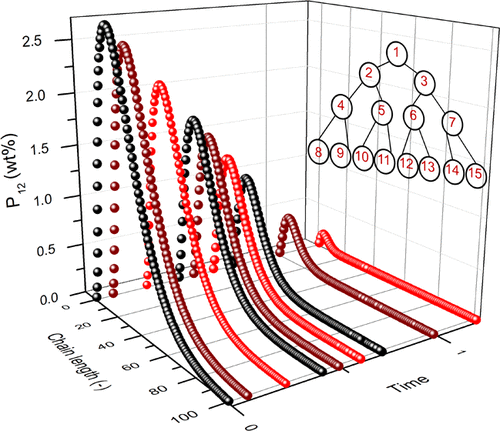当前位置:
X-MOL 学术
›
Ind. Eng. Chem. Res.
›
论文详情
Our official English website, www.x-mol.net, welcomes your
feedback! (Note: you will need to create a separate account there.)
Distribution Changes during Thermal Degradation of Poly(styrene peroxide) by Pairing Tree-Based Kinetic Monte Carlo and Artificial Intelligence Tools
Industrial & Engineering Chemistry Research ( IF 3.8 ) Pub Date : 2021-01-07 , DOI: 10.1021/acs.iecr.0c05414 Onur Dogu 1 , Pieter P. Plehiers 1 , Ruben Van de Vijver 1 , Dagmar R. D’hooge 1, 2 , Paul H. M. Van Steenberge 1 , Kevin M. Van Geem 1
Industrial & Engineering Chemistry Research ( IF 3.8 ) Pub Date : 2021-01-07 , DOI: 10.1021/acs.iecr.0c05414 Onur Dogu 1 , Pieter P. Plehiers 1 , Ruben Van de Vijver 1 , Dagmar R. D’hooge 1, 2 , Paul H. M. Van Steenberge 1 , Kevin M. Van Geem 1
Affiliation

|
A tree-based kinetic Monte Carlo (kMC) model is presented that differentiates between 38 end-group pairs for isothermal degradation of poly(styrene peroxide) (PSP). The binary trees allow for fast and accurate calculation of reaction probabilities, with mass-weighted binary trees for the accurate sampling of peroxide bond fissions and hydrogen abstractions along chains. The kinetic parameters are tuned via artificial neural networks (ANNs) to successfully predict literature experimental data, among other lumped product yields. ANNs are also utilized for sensitivity analysis to unravel the effects of individual reactions on the time evolution of experimental responses and other simulation outputs, including the variations of the chain length distributions of the macrospecies. PSP degradation is characterized by three stages of degradation considering both instantaneous and time-averaged concentrations. The first stage features rapid unzipping and results in the fast production of major products benzaldehyde and formaldehyde, the second stage features the most significant level of hydrogen abstractions involving PSP and other macrospecies types, and the third stage exhibits the consumption of the remaining peroxide bonds toward oligomeric species in a wide time frame until the degradation process is finalized by the depletion of peroxide bonds. This proof-of-concept study based on unprecedentedly detailed analyses of the chemistry via kinetic Monte Carlo paves the way to further improve our understanding of chemical recycling of solid plastic waste.
中文翻译:

基于树的动力学蒙特卡洛和人工智能工具配对的聚过氧化苯乙烯热降解过程中的分布变化
提出了一个基于树的动力学蒙特卡洛(kMC)模型,该模型区分了38个端基对,以等温降解聚环氧乙烷(PSP)。二叉树可快速准确地计算反应概率,而质量加权二叉树可用于沿链准确采样过氧化物键裂变和氢抽象。动力学参数可通过人工神经网络(ANN)进行调整,以成功预测文献实验数据以及其他集总产量。人工神经网络还用于敏感性分析,以揭示单个反应对实验响应和其他模拟输出(包括大物种的链长分布的变化)的时间演变的影响。PSP降解的特征在于考虑瞬时浓度和时间平均浓度的三个降解阶段。第一阶段的特点是快速解压并导致主要产品苯甲醛和甲醛的快速生产;第二阶段的特点是涉及PSP和其他大分子类型的氢的吸取量最高,而第三阶段则表现出剩余的过氧化物键被消耗掉了。在很长的时间范围内形成寡聚物种,直到通过过氧化物键的耗尽完成降解过程为止。这项概念验证研究基于动力学蒙特卡洛方法对化学物质进行了前所未有的详细分析,为进一步提高我们对固体塑料废物化学循环利用的理解铺平了道路。第一阶段的特点是快速解压并导致主要产品苯甲醛和甲醛的快速生产;第二阶段的特点是涉及PSP和其他大分子类型的氢的吸取量最高,而第三阶段则表现出剩余的过氧化物键被消耗掉了。在很长的时间范围内形成寡聚物种,直到通过过氧化物键的耗尽完成降解过程为止。这项概念验证研究基于动力学蒙特卡洛方法对化学物质进行了前所未有的详细分析,为进一步提高我们对固体塑料废物化学循环利用的理解铺平了道路。第一阶段的特点是快速解压并导致主要产品苯甲醛和甲醛的快速生产;第二阶段的特点是涉及PSP和其他大分子类型的氢的吸取量最高,而第三阶段则表现出剩余的过氧化物键被消耗掉了。在很长的时间范围内形成寡聚物种,直到通过过氧化物键的耗尽完成降解过程为止。这项概念验证研究基于动力学蒙特卡洛方法对化学物质进行了前所未有的详细分析,为进一步提高我们对固体塑料废物化学循环利用的理解铺平了道路。第二阶段的特征是涉及PSP和其他大型物种的氢的提取水平最高,而第三阶段则表现出在很长的时间范围内剩余的过氧化物键向低聚物种的消耗,直到降解过程因过氧化物键的耗尽而最终确定。 。这项概念验证研究基于动力学蒙特卡洛方法对化学物质进行了前所未有的详细分析,为进一步提高我们对固体塑料废物化学循环利用的理解铺平了道路。第二阶段的特征是涉及PSP和其他大型物种的氢的提取水平最高,而第三阶段则表现出在很长的时间范围内剩余的过氧化物键向低聚物种的消耗,直到降解过程因过氧化物键的耗尽而最终确定。 。这项概念验证研究基于动力学蒙特卡洛方法对化学物质进行了前所未有的详细分析,为进一步提高我们对固体塑料废物化学循环利用的理解铺平了道路。
更新日期:2021-03-03
中文翻译:

基于树的动力学蒙特卡洛和人工智能工具配对的聚过氧化苯乙烯热降解过程中的分布变化
提出了一个基于树的动力学蒙特卡洛(kMC)模型,该模型区分了38个端基对,以等温降解聚环氧乙烷(PSP)。二叉树可快速准确地计算反应概率,而质量加权二叉树可用于沿链准确采样过氧化物键裂变和氢抽象。动力学参数可通过人工神经网络(ANN)进行调整,以成功预测文献实验数据以及其他集总产量。人工神经网络还用于敏感性分析,以揭示单个反应对实验响应和其他模拟输出(包括大物种的链长分布的变化)的时间演变的影响。PSP降解的特征在于考虑瞬时浓度和时间平均浓度的三个降解阶段。第一阶段的特点是快速解压并导致主要产品苯甲醛和甲醛的快速生产;第二阶段的特点是涉及PSP和其他大分子类型的氢的吸取量最高,而第三阶段则表现出剩余的过氧化物键被消耗掉了。在很长的时间范围内形成寡聚物种,直到通过过氧化物键的耗尽完成降解过程为止。这项概念验证研究基于动力学蒙特卡洛方法对化学物质进行了前所未有的详细分析,为进一步提高我们对固体塑料废物化学循环利用的理解铺平了道路。第一阶段的特点是快速解压并导致主要产品苯甲醛和甲醛的快速生产;第二阶段的特点是涉及PSP和其他大分子类型的氢的吸取量最高,而第三阶段则表现出剩余的过氧化物键被消耗掉了。在很长的时间范围内形成寡聚物种,直到通过过氧化物键的耗尽完成降解过程为止。这项概念验证研究基于动力学蒙特卡洛方法对化学物质进行了前所未有的详细分析,为进一步提高我们对固体塑料废物化学循环利用的理解铺平了道路。第一阶段的特点是快速解压并导致主要产品苯甲醛和甲醛的快速生产;第二阶段的特点是涉及PSP和其他大分子类型的氢的吸取量最高,而第三阶段则表现出剩余的过氧化物键被消耗掉了。在很长的时间范围内形成寡聚物种,直到通过过氧化物键的耗尽完成降解过程为止。这项概念验证研究基于动力学蒙特卡洛方法对化学物质进行了前所未有的详细分析,为进一步提高我们对固体塑料废物化学循环利用的理解铺平了道路。第二阶段的特征是涉及PSP和其他大型物种的氢的提取水平最高,而第三阶段则表现出在很长的时间范围内剩余的过氧化物键向低聚物种的消耗,直到降解过程因过氧化物键的耗尽而最终确定。 。这项概念验证研究基于动力学蒙特卡洛方法对化学物质进行了前所未有的详细分析,为进一步提高我们对固体塑料废物化学循环利用的理解铺平了道路。第二阶段的特征是涉及PSP和其他大型物种的氢的提取水平最高,而第三阶段则表现出在很长的时间范围内剩余的过氧化物键向低聚物种的消耗,直到降解过程因过氧化物键的耗尽而最终确定。 。这项概念验证研究基于动力学蒙特卡洛方法对化学物质进行了前所未有的详细分析,为进一步提高我们对固体塑料废物化学循环利用的理解铺平了道路。











































 京公网安备 11010802027423号
京公网安备 11010802027423号